Introduction
Before embarking on any project, especially those of high complexity and impact, it is crucial to lay a strong foundation through meticulous planning and thorough research. The Discovery Phase stands as an essential pillar in project management, ensuring that every subsequent step is grounded in a deep understanding of the project's scope, objectives, and potential risks. This article delves into why the Discovery Phase is indispensable, highlighting its role in mitigating risks, aligning stakeholder expectations, and setting the stage for a structured and predictable project lifecycle.
Drawing insights from real-world case studies, such as TBC Bank's agile transformation and the construction of the Hoover Dam, alongside statistical evidence from the World Bank Group, this exploration underscores the significance of investing time and resources in the Discovery Phase. By the end, readers will grasp the critical objectives, steps, and common pitfalls associated with this phase, equipping them with the knowledge to navigate complexities and drive successful project outcomes.
Why the Discovery Phase is Essential
'The Discovery Phase is a critical element of management, as it lays the groundwork for successful execution.'. During this stage, teams gather essential information that helps define the initiative's scope, objectives, and timeline. This phase is particularly crucial in complex projects, such as large-scale software development and digital transformations, where the stakes are high, and the room for error is minimal.
Case studies, such as TBC Bank's agile transformation, highlight the significance of the Exploration Stage. TBC Bank aimed to expand internationally and transform into a more digital business while reducing organizational complexity. Despite adopting agile principles, the bank faced significant challenges due to dependencies between teams and technical debt. The Discovery Phase could have reduced these issues by recognizing potential challenges and aligning stakeholder expectations early on.
Lessons from the construction of the Hoover Dam, one of America's most iconic engineering achievements, also emphasize the importance of thorough planning and discovery. Despite the challenges posed by the Great Depression, the Hoover Dam was completed two years ahead of schedule, demonstrating how meticulous planning and managing complexities can lead to successful project outcomes. The dam's construction involved pouring an unprecedented amount of concrete, highlighting the necessity of detailed preparation and risk management.
Statistics from the World Bank Group further support the importance of the Exploration Phase. Projects that underwent adaptive management and restructuring during the COVID-19 pandemic saw improved performance and successful outcomes. This adaptive method highlights the necessity for a well-organized Initial Phase to enable adaptation and guarantee evidence-based decision-making.
In essence, by investing time in the Exploration Phase, organizations can minimize risks, align stakeholder expectations, and ensure that the final deliverables meet user needs. This phase establishes the groundwork for a structured and predictable lifecycle, enabling teams to navigate complexities and achieve their objectives efficiently.
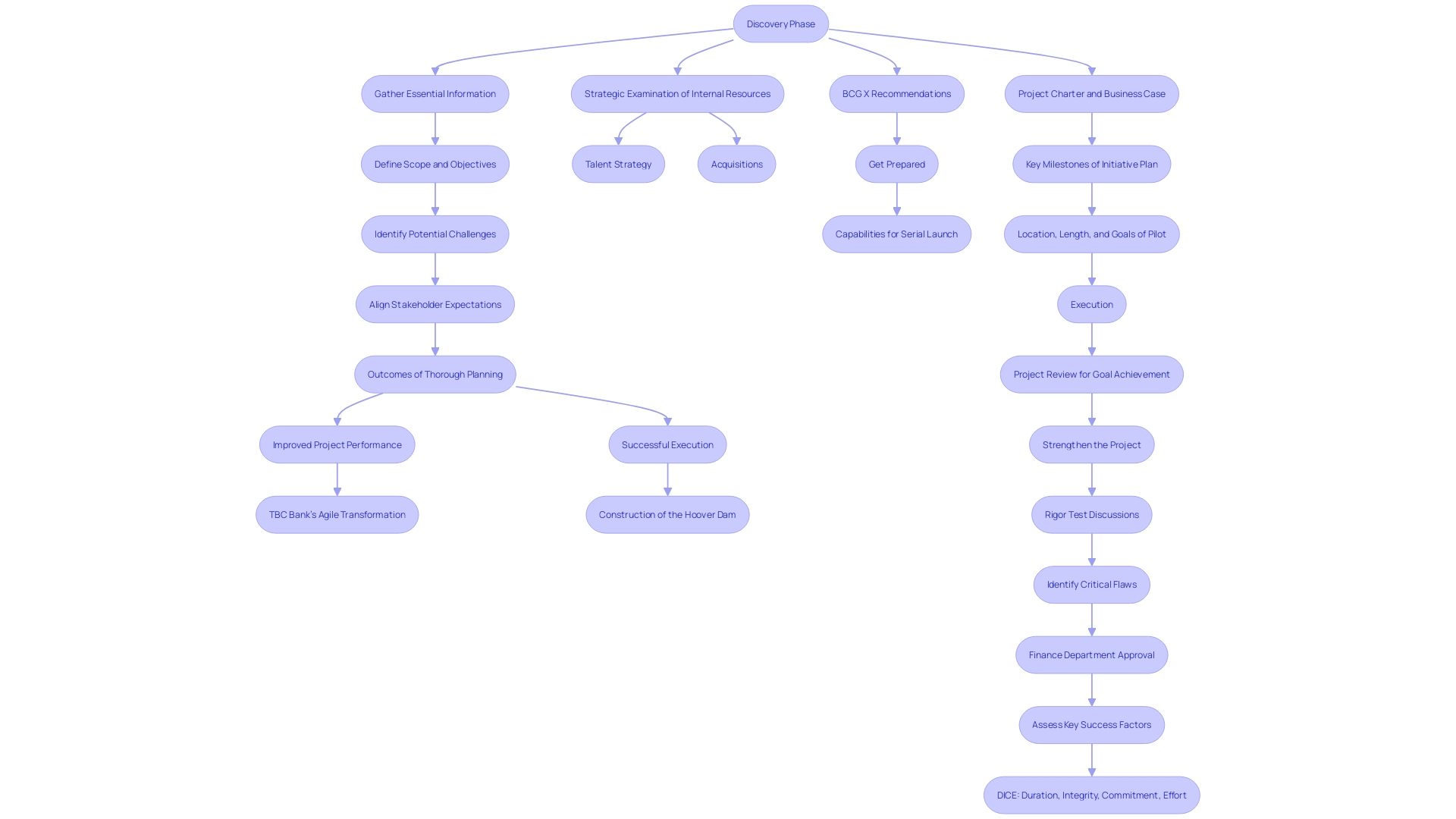
Key Objectives of the Discovery Phase
The Discovery Phase is crucial in laying the groundwork for a successful initiative. It begins with understanding user requirements through a blend of qualitative and quantitative research methods, such as A/B tests, usability tests, and prototype testing with real users. This stage also emphasizes recognizing limitations and outlining the scope of the initiative, ensuring that all participants' needs are taken into account and correctly reflected in the plan. A key objective is to establish clear goals to guide the initiative's direction.
Effective communication and consistent terminology are essential during this phase. Maintaining a shared glossary among all stakeholders ensures everyone is on the same page, enhancing clarity and reducing misunderstandings. This phase also involves assessing potential risks and opportunities that could impact the initiative's success, leveraging data analytics to identify patterns and inform decisions.
By triangulating data from multiple sources and conducting thorough research, teams can gain a comprehensive understanding of the factors that contribute to success. This approach not only helps in managing stakeholder expectations but also in setting realistic goals and timelines. Ultimately, the initial phase aims to create a solid foundation for the initiative's subsequent stages, enabling flexibility and innovation in design and implementation.

Steps to Conduct an Effective Discovery Phase
To conduct an effective Discovery Phase, follow these essential steps:
-
Requirements Gathering: Begin by collecting detailed requirements for the endeavor. This involves understanding the needs, goals, and limitations of the undertaking. According to studies, about 40% of endeavors fail due to unclear or lack of requirements. Engaging with stakeholders through thorough interviews and surveys can mitigate this risk.
-
Market and User Research: Gather all relevant market and user data to inform your decisions. This includes understanding user behaviors, market trends, and competitive landscape. This step ensures that the initiative aligns with user needs and market demands.
-
Scope Definition: Clearly outline the boundaries of the endeavor. This includes outlining the deliverables, tasks, and timelines. Avoiding scope creep is critical, and setting realistic expectations from the start can prevent common pitfalls such as mismatched visions and impossible timelines.
-
System Architecture Design: Develop a high-level system architecture. This step provides a blueprint for the technical structure of the endeavor, ensuring that all components work together seamlessly. It's essential for laying down a solid foundation before coding begins.
-
Risk Management: Identify potential threats and develop mitigation strategies. Efficient management of uncertainties can prevent unexpected changes and keep the project on track. This involves regular monitoring and adapting as new risks emerge.
-
Prototyping and Feedback Loops: Create prototypes and gather feedback from stakeholders. This iterative process allows for continuous improvement and ensures the final product meets user needs. Employing feedback loops aids in enhancing the initiative and tackling any problems promptly.
-
Quality Assurance Measures: Implement robust testing protocols to maintain high standards of software quality. Continuous testing and quality control are essential for delivering a reliable and functional product.
By adhering to these measures, you can guarantee a thorough and efficient initial phase, establishing the groundwork for successful execution.

Establish Clear Objectives
Clearly defining your objectives during the Discovery Phase is essential for guiding the entire initiative. Concentrate on recognizing essential user requirements, comprehending technical limitations, and establishing achievable timelines. By establishing well-defined goals, you provide clear direction and focus for all parties involved. For instance, dividing the codebase into manageable components can facilitate parallel development and reduce risks of delays. Engaging in early and significant discussions with stakeholders, such as service developers and data owners, ensures that potential issues are addressed promptly. 'As one initiative demonstrated, providing clear examples during testing and discussions helped clarify requirements and led to timely delivery.'. Setting these objectives early on not only aligns the team but also helps in managing and mitigating technical debt, ensuring a more robust and scalable solution. Automated testing, monitoring, and adopting a microservices architecture can further enhance the agility and efficiency of the development process, contributing to the overall success of the endeavor.
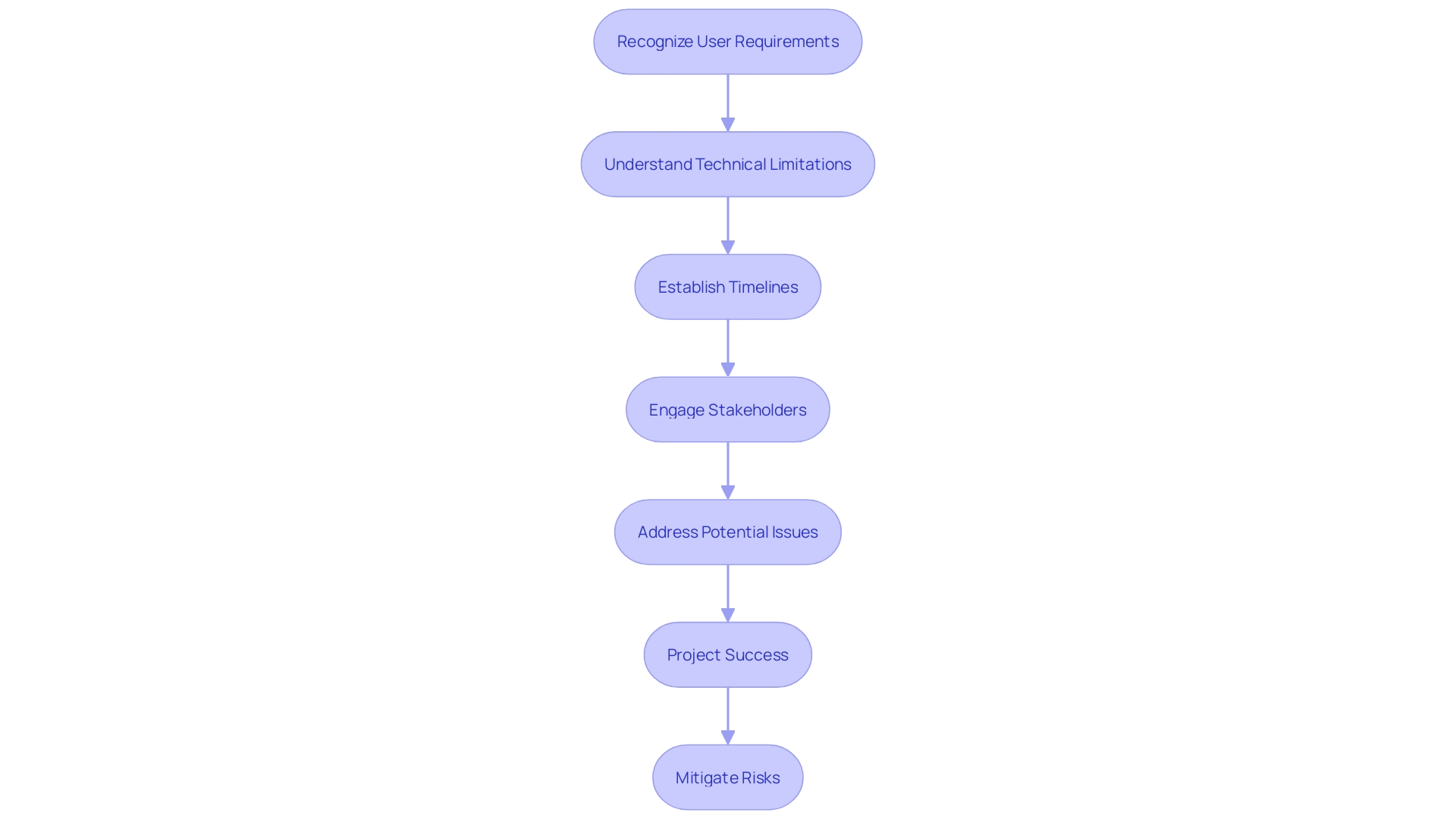
Gather Information and Understand Requirements
Gathering data from diverse sources such as interviews, surveys, and market research is essential. Interacting with interested parties and end-users to comprehend their needs and expectations is essential. This step is reinforced by a study involving 21 interviews across 13 product development companies, highlighting the importance of qualitative and quantitative methods to infer end-user preferences. Additionally, continuous collection and analysis of user feedback, despite its challenges, play a significant role in informed decision-making. Ensuring sufficient resources for interpreting this feedback, possibly facilitated by telemetry dashboards, is recommended to address the complexities in selecting the right metrics and analysis techniques.
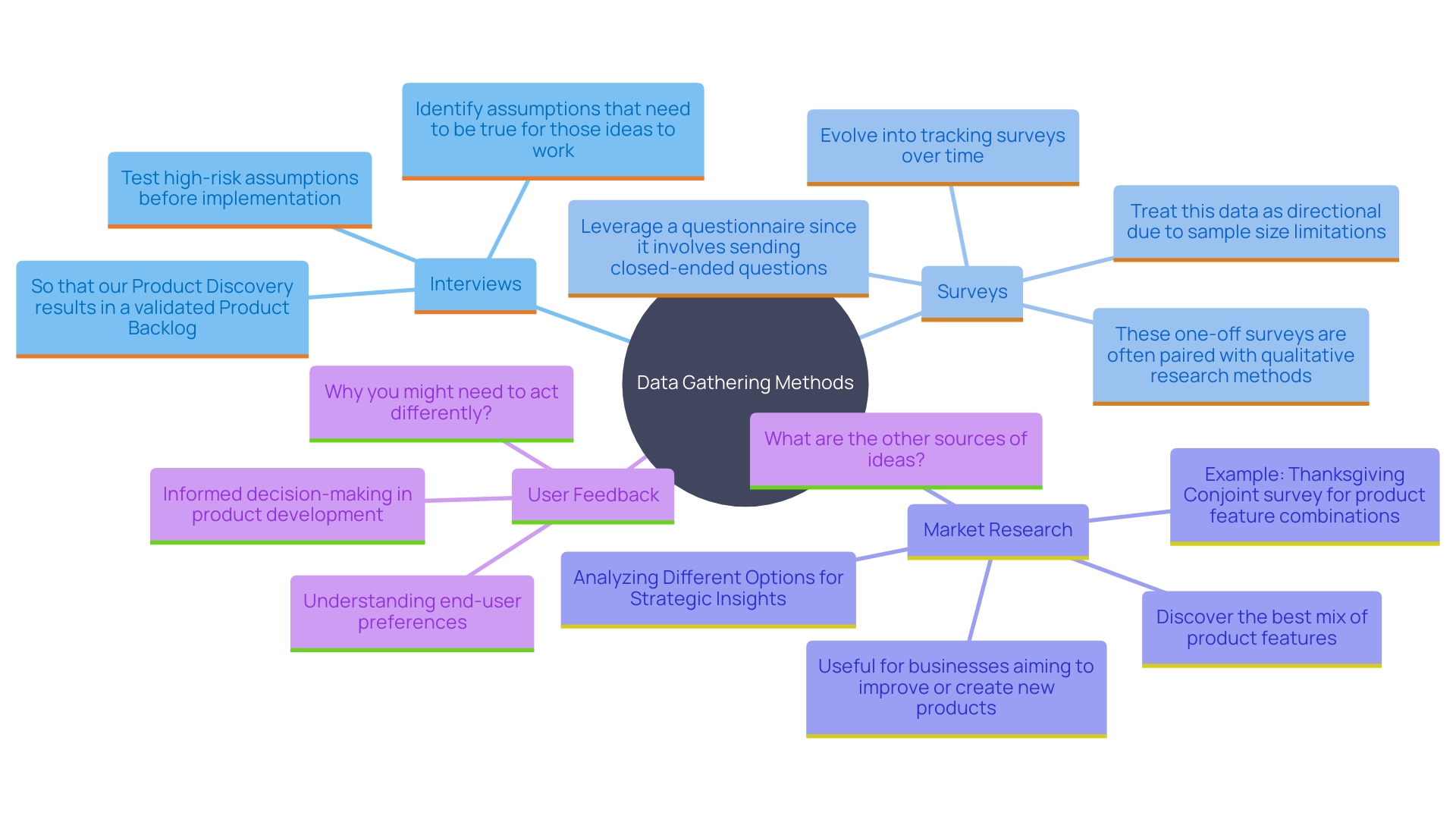
Define the Project Scope
Clearly delineate the boundaries of the initiative by specifying what is included and what is excluded. A well-defined scope is crucial for preventing scope creep and ensuring alignment among all stakeholders. This involves creating a detailed scope statement that clearly defines the boundaries, objectives, and deliverables of the endeavor. Utilizing management software can assist in creating a schedule that takes into account task dependencies, resource availability, and constraints. It's essential to monitor progress and manage any deviations meticulously to maintain the scope and integrity of the work. Carrying out a post-assessment can provide valuable insights and assist in documenting best practices for future endeavors, ensuring continuous improvement and successful completions.
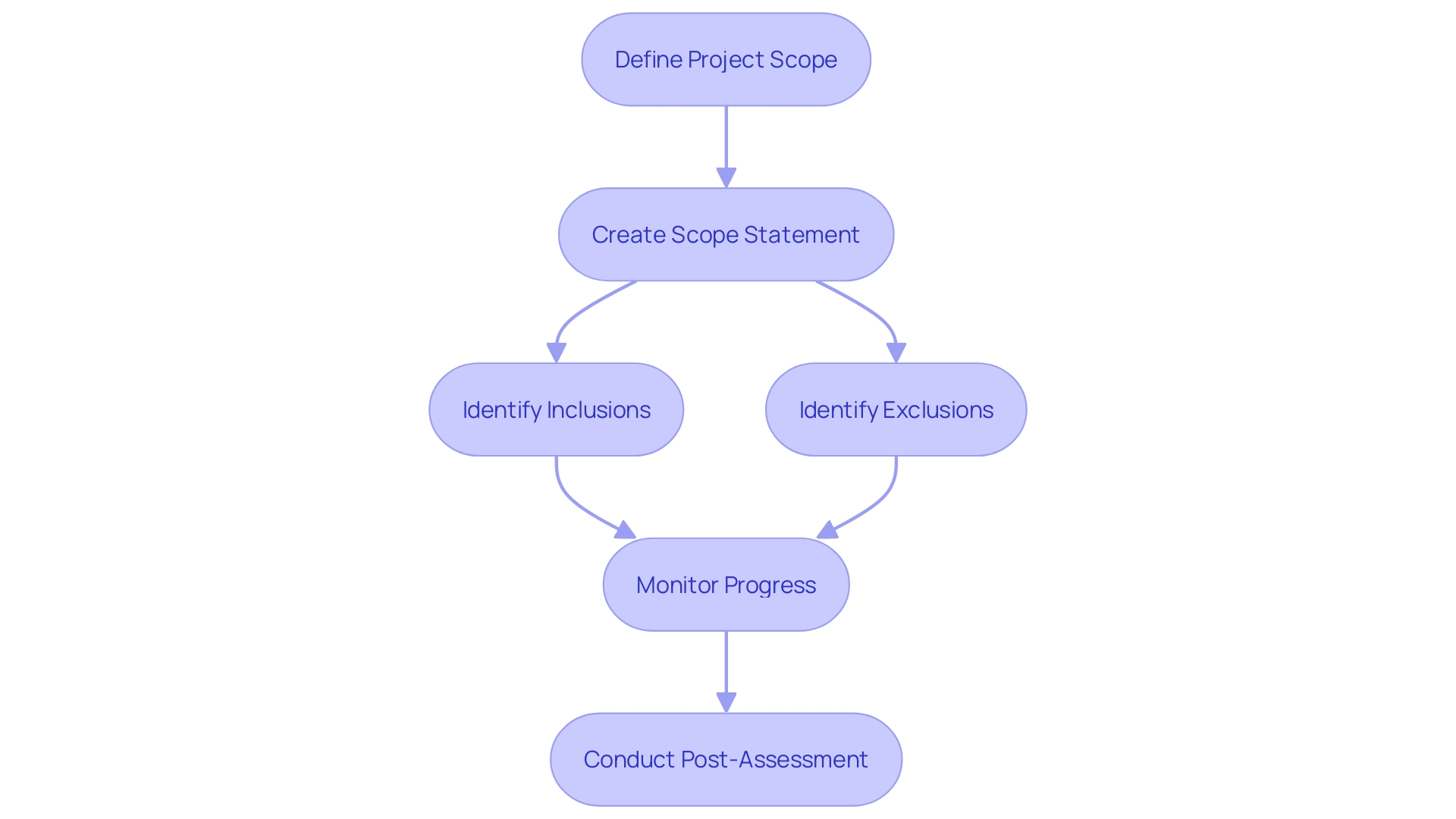
Identify Stakeholders and Their Roles
Recognizing essential participants and outlining their responsibilities is vital for the success of any project. Key participants typically include investors, executives, employees, customers, and suppliers. As environmental and social governance (ESG) becomes more prominent, interested parties also expand to include governments, trade associations, environmental agencies, and local communities. For example, a chemical manufacturer planning a new product line must consider both employees and surrounding communities during decision-making.
Stakeholder analysis is a crucial method in management for identifying individuals, groups, and organizations that have a vested interest in or can influence your endeavor. This approach helps prioritize stakeholders effectively, ensuring their needs and expectations are understood early on. By minimizing potential conflicts and disruptions, it prepares the endeavor for success. Consistent communication and proactive relationship management are essential to satisfying all parties' needs throughout the lifecycle.
Mapping tools for participants, such as the power-interest grid, can classify them based on their influence and interest levels. This methodology helps identify key players and determine the best strategies for managing relationships with them. Individuals with significant influence and interest, such as decision-makers or project sponsors, require careful management through consistent communication and active teamwork. 'High-power, low-interest parties, often internal executives, require satisfaction but less frequent interaction.'.
Effective management of interested parties involves developing engagement strategies tailored to each group. For instance, during the development of new surgical equipment, surgeons—high-power, high-interest stakeholders—should be consulted early in the design process to ensure the tool meets their needs. Meanwhile, regulatory bodies, such as the FDA, need detailed compliance documentation to demonstrate the equipment’s safety and efficacy.
By thoroughly understanding and managing stakeholders, managers can navigate complexities, align expectations, and foster a collaborative environment, ultimately leading to a successful outcome.
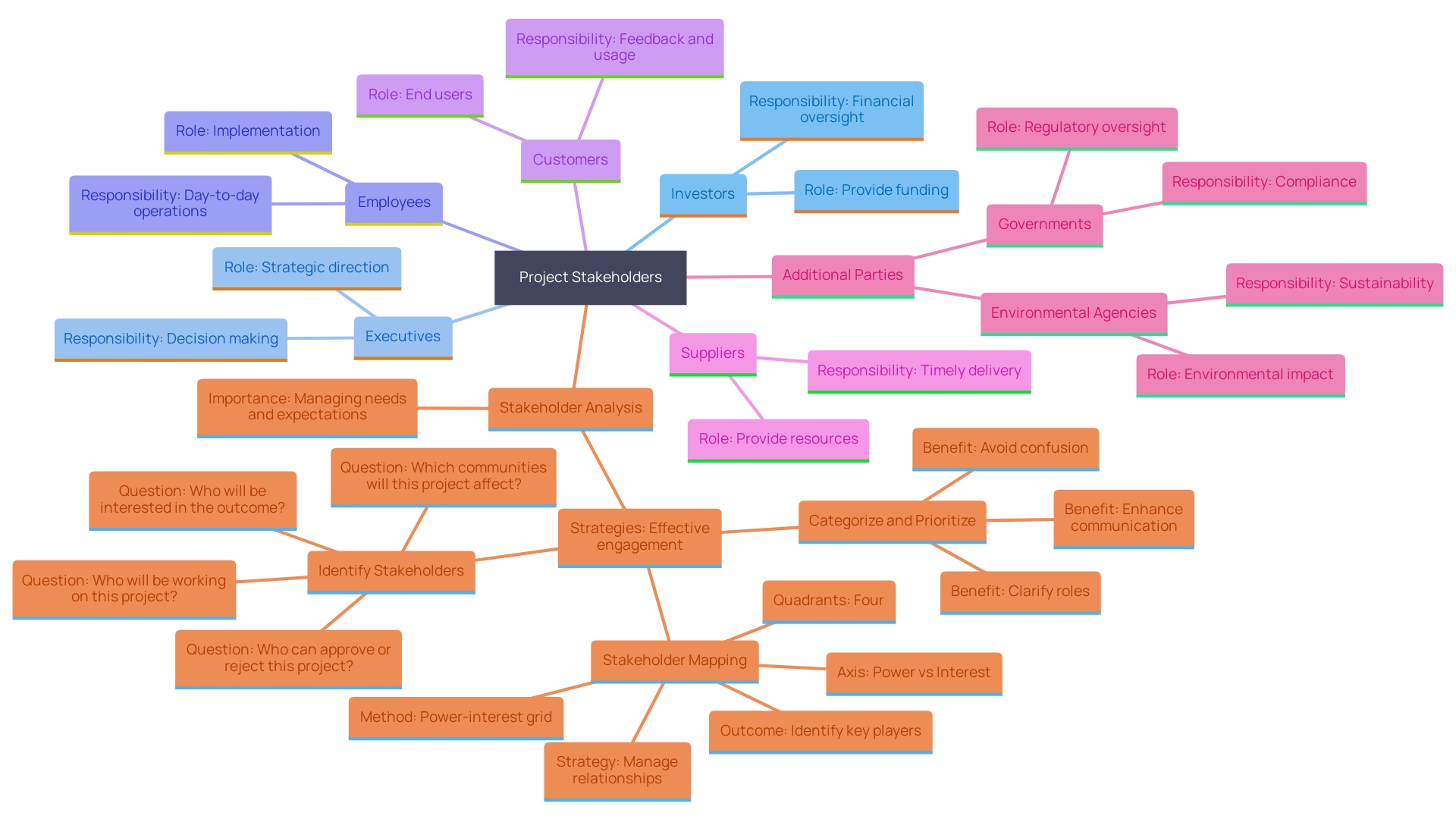
Determine Technical and Non-Functional Requirements
Recognizing both technical and non-functional requirements is essential for the success of any endeavor. These requirements encompass performance metrics, security standards, and usability considerations that ensure the initiative meets its objectives.
Technical Environment: It's essential to describe the hardware, software, and network infrastructure supporting the core system. This includes outlining the organizational environment, relevant processes, and the organizational structure that will impact the system. Grasping the technical environment assists in aligning the initiative with existing systems and anticipating potential challenges.
Performance Metrics: Performance testing involves multiple stakeholders, including developers, testers, and system administrators, to ensure the system can handle a large number of simultaneous users or transactions. Load testing, for instance, measures the system's performance under heavy loads to identify any bottlenecks. Establishing a baseline for performance is necessary, albeit challenging due to the continuously changing technology landscape.
Security Standards: Security is paramount, especially when dealing with sensitive data. Establishing robust security standards protects against potential threats and ensures compliance with regulatory requirements. These standards must be integrated into the initiative from the outset to mitigate risks effectively.
Usability Considerations: Usability directly impacts user satisfaction and efficiency. Ensuring the system is user-friendly and meets customer expectations can significantly enhance user retention. Metrics such as Customer Lifetime Value (CLV) can offer insights into the long-term value obtained from customer relationships, highlighting the significance of usability in achieving success.
Regulatory and Compliance Requirements: Adhering to legal and regulatory requirements is non-negotiable. Recognizing these requirements early on ensures the initiative remains compliant and avoids any legal complications.
In summary, addressing these technical and non-functional requirements through a comprehensive approach ensures the initiative's robustness, security, and usability, ultimately leading to its success.
Assess Risks and Constraints
Assessing possible challenges and limitations is essential in management, particularly in the ever-changing area of software development. Identifying these challenges upfront enables the formulation of proactive mitigation strategies tailored to specific project needs. For example, Uber's approach to managing uncertainties illustrates the importance of customizing challenges based on user behavior and regional differences. Their implementation of penny drop verification to detect fraudulent activities highlights the need for adaptable and robust evaluation practices.
'A comprehensive threat management framework should be dynamic and data-driven, mirroring the evolving nature of digital dangers.'. Research from MIT emphasizes the necessity of a flexible approach to quantifying uncertainty in the software supply chain, advocating for the incorporation of human aspects and trust metrics. This adaptability guarantees that threat evaluation stays precise and pertinent, even as new dangers arise.
Additionally, insights from real-world applications, such as the security assessments of web applications from 2021 to 2023, underline the diversity in programming languages and architectures used. This diversity necessitates a tailored evaluation approach, considering varying vulnerabilities and constraints.
By utilizing advanced risk management software, managers can continually monitor potential risks, assign mitigation strategies, and evaluate their impact on timelines and budgets. 'This proactive stance not only enhances stability but also supports more informed decision-making, crucial for successful outcomes.'.
Develop a Preliminary Project Plan
Developing a preliminary plan is essential for the successful execution of any software development endeavor. This plan acts as a comprehensive guide that details essential milestones, deliverables, and timelines, ensuring that all team efforts are aligned and concentrated on accomplishing the objectives.
To illustrate this, consider the case of Facile Technolab, which partnered with an Australian tech startup to develop a Manufacturing Execution System (MES) for the medical industry. Facile Technolab's initiative plan was pivotal in managing the complex requirements and ensuring compliance with government regulations. The plan included specific, measurable, achievable, relevant, and time-bound (SMART) objectives, breaking down the initiative into smaller, manageable tasks and sub-tasks. This approach not only organized the work effectively but also allowed for the efficient allocation of resources.
A well-structured plan also incorporates automated testing and monitoring tools, as emphasized in modern DevOps practices. This ensures that production problems are identified and resolved quickly, maintaining high code quality throughout the development process. Additionally, employing a microservices architecture can enhance agility, allowing teams to develop, deploy, and scale services independently.
By following these structured methodologies and utilizing advanced tools, software development initiatives can achieve their goals efficiently and effectively, as demonstrated by the successful deployment of the MES platform by Facile Technolab.
Document Findings and Create a Discovery Report
Combine all the gathered information and insights into a comprehensive Discovery Report. This essential document should summarize the initiative's goals, major discoveries, and initial plans, acting as a guide for all parties involved. For instance, in a collaborative effort between Ripley and Thoughtworks, an in-depth analysis and research into customer behavior revealed significant shortcomings in Ripley's mobile user experience. As a result, the discovery phase led to the development of a mobile application to improve conversion rates and meet customer demands for a seamless shopping experience. By compiling such detailed insights and strategic plans, involved parties can better understand the direction and requirements of the project, ensuring everyone is aligned and prepared for the next steps.
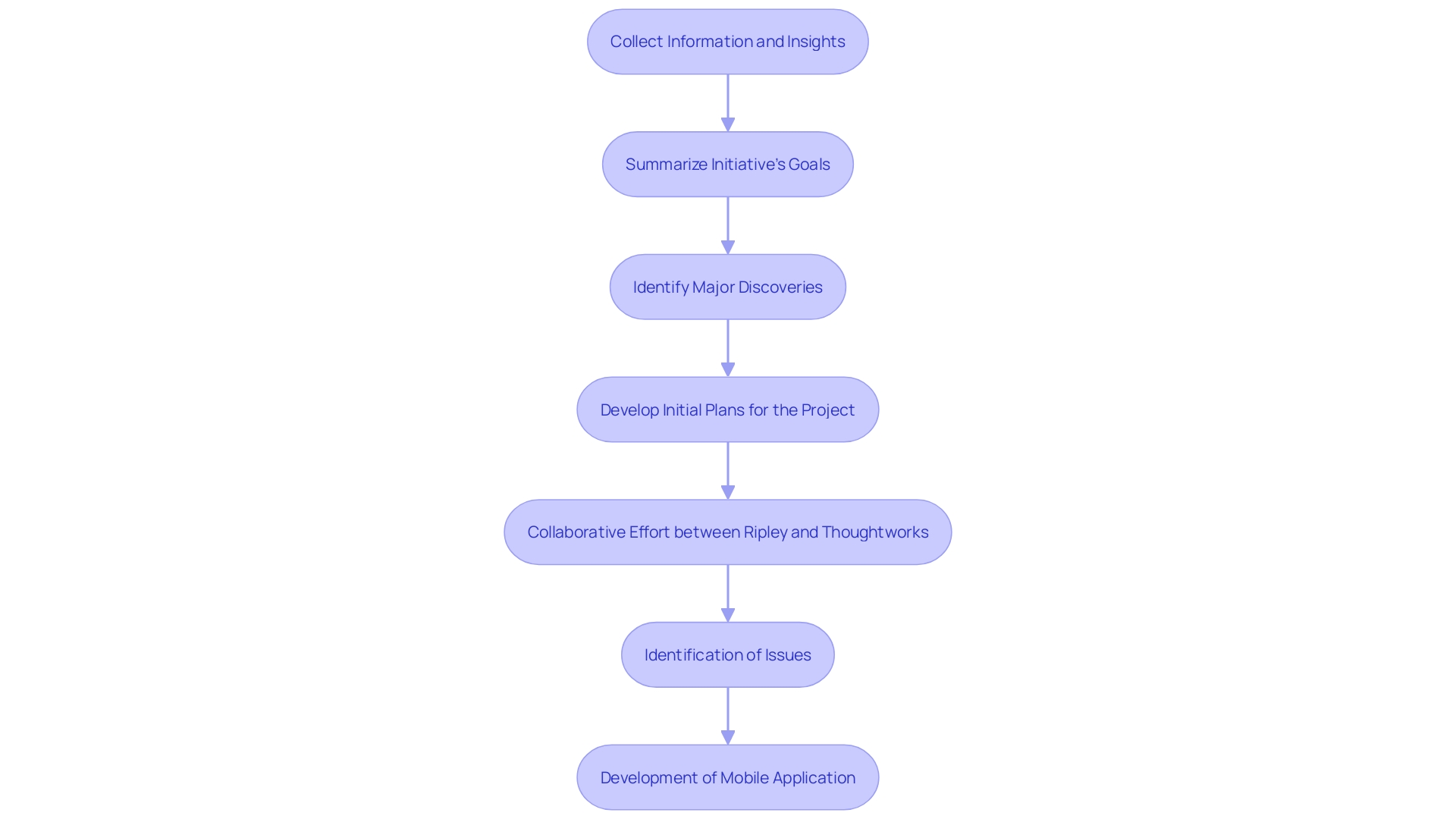
Next Steps After the Discovery Phase
Once the initial phase is complete, transitioning to the planning and execution phases becomes imperative. This transition begins with a thorough review of the Discovery Report with key stakeholders, ensuring that every insight and recommendation is fully understood and agreed upon. This step reflects the careful planning and resource distribution observed in significant undertakings like the Hoover Dam, which, despite its complexity and the challenges of the Great Depression, was finished ahead of schedule. Just as the dam's success depended on clear communication and precise planning, so too does a software endeavor rely on a detailed plan that outlines every step and identifies all necessary resources.
Incorporating agile methodologies such as Scrum can further streamline this process. By dividing the initiative into smaller, manageable units and prioritizing tasks based on their impact, teams can foster continuous improvement and maintain constant communication. This approach encourages a self-managed team structure, reducing dependencies and enhancing efficiency. Tools like OrangeScrum and Notion can serve as centralized sources of truth, ensuring that all team members are aligned and informed.
Furthermore, leveraging modern DevOps practices, such as automated testing and monitoring, can significantly enhance the initiative's robustness and scalability. By implementing microservices architecture, teams can independently develop and deploy services, thus increasing agility and reducing time to market. This holistic approach not only ensures that the initiative stays on track but also aligns with the broader goals of delivering high-quality, scalable, and efficient software solutions.
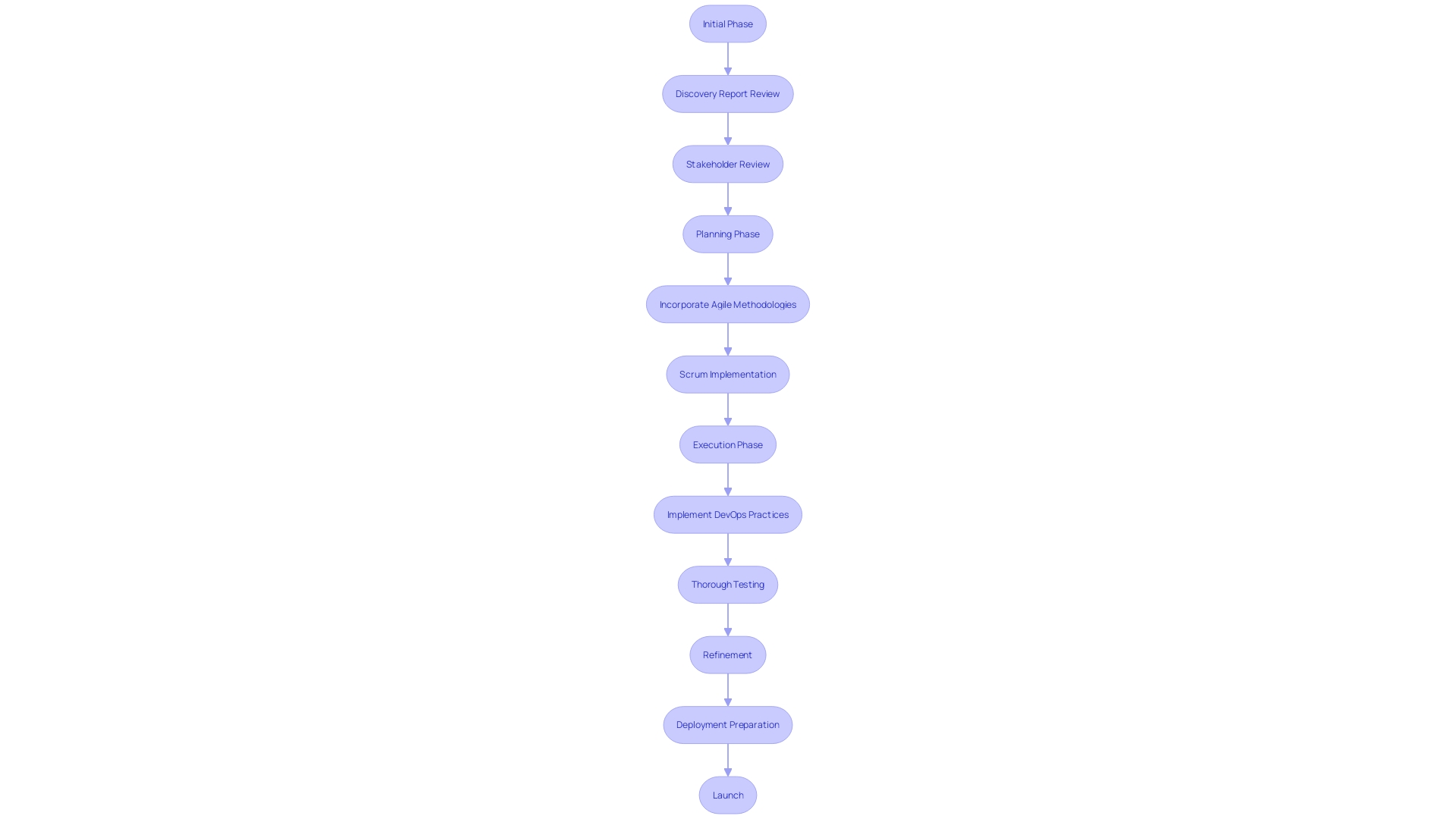
Common Pitfalls to Avoid in the Discovery Phase
One of the significant pitfalls in the Agile Discovery process is insufficient stakeholder engagement. Ensuring that all relevant parties are involved from the outset can prevent misunderstandings and miscommunications, which are common reasons for AI endeavors failing. Clear objectives are another critical factor; well-defined goals provide direction and focus, ensuring that the team remains aligned and productive. Effective documentation is equally important, as it enhances transparency, accountability, and risk management. For instance, an initiative that improved aid distribution's efficiency and security through an integrated web platform benefited over 3 million people across 14 countries in just one year by maintaining rigorous documentation and clear objectives. Avoiding these common pitfalls will significantly enhance the effectiveness of the Discovery Phase and set the project on a path to success.
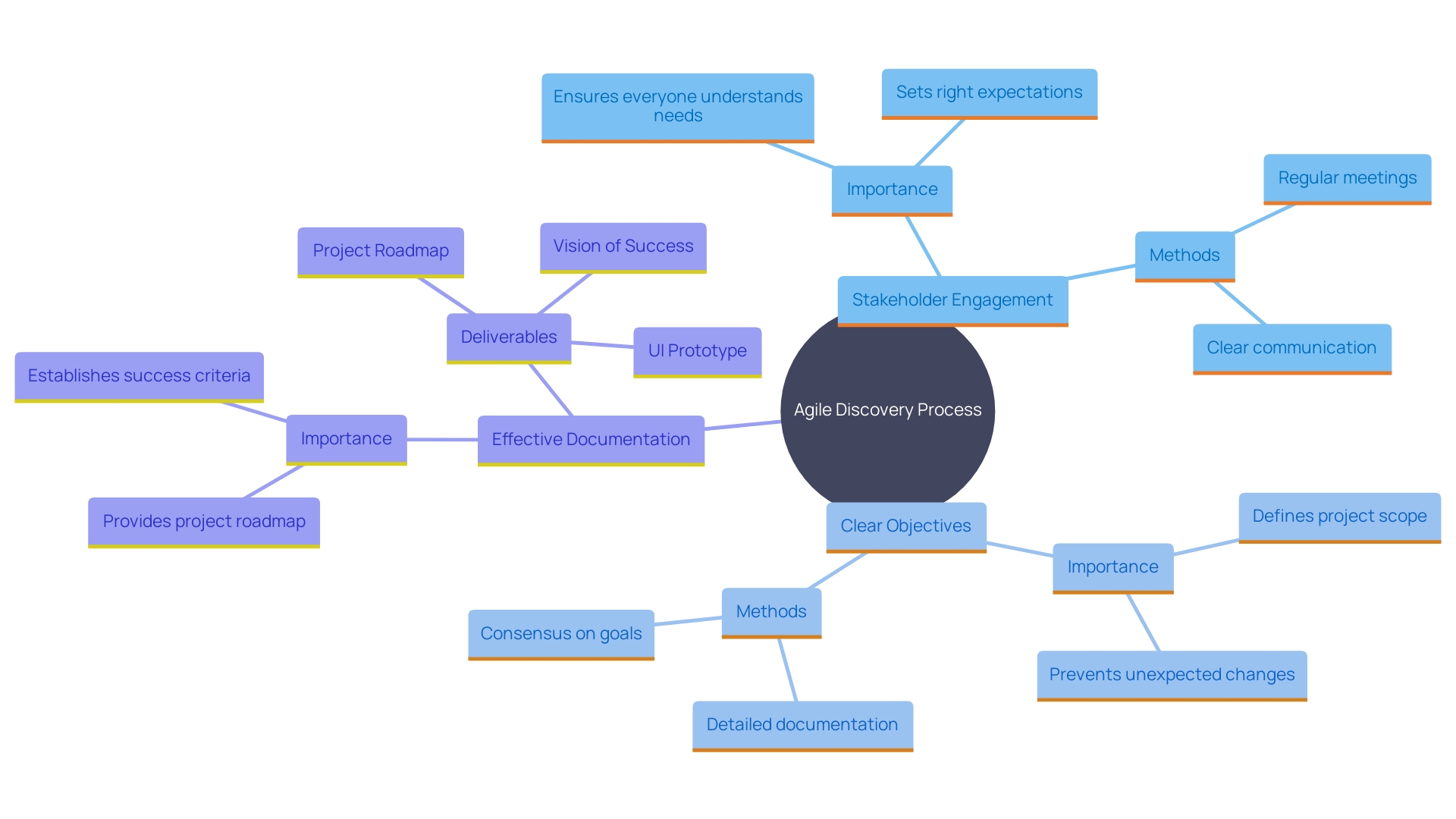
Conclusion
The Discovery Phase is undeniably a cornerstone of effective project management, serving as the bedrock upon which successful projects are built. By emphasizing thorough planning and comprehensive research, this phase ensures that projects are aligned with stakeholder expectations and equipped to navigate potential challenges. Real-world examples, such as TBC Bank's agile transformation and the construction of the Hoover Dam, provide compelling evidence of how meticulous preparation can lead to successful outcomes, even in the face of significant complexities.
Key objectives of the Discovery Phase include gathering user requirements, defining project scope, and establishing clear goals. Effective communication and stakeholder engagement are paramount, as they facilitate a shared understanding and minimize the risk of misalignment. By systematically assessing risks and constraints, teams can develop proactive strategies that enhance project stability and adaptability.
The steps outlined for conducting an effective Discovery Phase—ranging from requirements gathering to risk management—underscore the importance of a structured approach to project initiation.
Transitioning smoothly from the Discovery Phase to planning and execution is critical for maintaining momentum. By utilizing agile methodologies and modern DevOps practices, teams can foster continuous improvement and ensure that all project components are aligned with overarching objectives. Moreover, avoiding common pitfalls such as insufficient stakeholder engagement and unclear objectives can significantly enhance the effectiveness of the Discovery Phase.
In summary, investing time and resources in the Discovery Phase is essential for minimizing risks and setting the stage for successful project execution. By adhering to best practices and leveraging insights from past projects, organizations can navigate complexities with confidence, ultimately delivering high-quality outcomes that meet user needs and stakeholder expectations.





